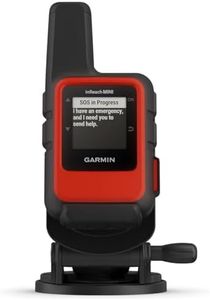We Use CookiesWe use cookies to enhance the security, performance,
functionality and for analytical and promotional activities. By continuing to browse this site you
are agreeing to our privacy policy
5 Best Marine Radios
From leading brands and best sellers available on the web.Buying Guide for the Best Marine Radios
Choosing the right marine radio is essential for anyone spending time on the water, whether you’re boating for leisure, fishing, or involved in water sports. The right radio keeps you connected for safety, navigation, and general communication. When picking a marine radio, you need to consider how and where you plan to use it, the size of your vessel, and the kind of communication range you need.VHF vs. UHFThis refers to the frequency band the radio uses to send and receive messages. Most marine radios use Very High Frequency (VHF), which is standard for communication between boats and with coastguard stations because it travels well over water without needing large antennas. UHF (Ultra High Frequency) radios are uncommon for marine use and are more suitable for land-based operations. For marine activity, always go for a VHF radio because it is designed for your environment and the channels used are internationally recognized for maritime safety.
Fixed-Mount vs. HandheldMarine radios come as either fixed-mount units that are installed on your boat or as portable handheld devices. Fixed-mount radios are generally more powerful and have longer range but are only usable while onboard. Handheld radios are convenient, portable, and buoyant (sometimes even waterproof), but typically have less range and battery life. If you have a larger vessel or regularly go far from shore, a fixed mount may be best. For smaller boats, kayaks, or dinghies, a handheld can be ideal. Some users choose to carry both for backup.
Transmitting PowerTransmitting power, measured in watts, affects how far your signal will reach. Marine VHF radios typically offer 1 watt (for close communication) and up to 25 watts (for maximum range). If you only ever stay near shore or crowded waterways, lower power is sufficient. If you sail or fish offshore, higher transmitting power is essential to reach distant help or other boats.
Waterproof and Weather ResistanceSince marine radios are used in wet and sometimes rough conditions, waterproofing is crucial. Radios are rated for their ability to resist water and dust, usually following IPX standards. A higher IPX rating means better protection—an IPX7 or IPX8 device can handle being submerged, making it a good fit for open boats or unpredictable weather. Choose a radio with a high waterproof rating if you're likely to get splashed or caught in rain.
Display and ControlsThe display shows important information like channel numbers and emergency alerts, while controls let you quickly switch channels, volume, or call for help. Larger, clearer displays and simple controls make a big difference in rough seas or low light. If you'll be using the radio in challenging conditions or need to respond quickly, look for radios with clear, backlit displays and large, easy-to-use buttons.
DSC Capability (Digital Selective Calling)DSC is a feature that allows you to send a distress signal, including your location, at the press of a button. This can summon help much faster than a normal voice call, which is vital in emergencies. Radios with DSC usually require you to register with authorities and connect to a GPS for location data. If safety is a top concern, or you spend time offshore, look for a radio with DSC.
Battery Life (for Handhelds)Battery life determines how long your handheld radio will last between charges. Longer battery life is important for extended trips or if you won’t have access to charging, such as while camping or on multi-day journeys. If you use your radio for short, casual outings, most battery options will suffice, but for longer adventures, choose a radio known for long battery life or one that allows you to swap in fresh batteries.
Antenna QualityThe quality and length of the antenna affect how well the radio can send and receive signals. Fixed-mount radios usually have external antennas, which greatly increase their range. Handhelds have built-in, often shorter antennas, so their range is lower. For maximum reliability and range on larger vessels, an external, high-quality antenna is a must, but for occasional or short-range use, the standard antenna on a handheld should be enough.
NOAA Weather AlertsSome marine radios can automatically receive weather alerts from the NOAA (National Oceanic and Atmospheric Administration) or other local meteorological services. This is especially useful for keeping safe in changing weather. If you want to be kept informed about storms, high winds, or other conditions, choose a model that can access weather channels and issue alerts.




